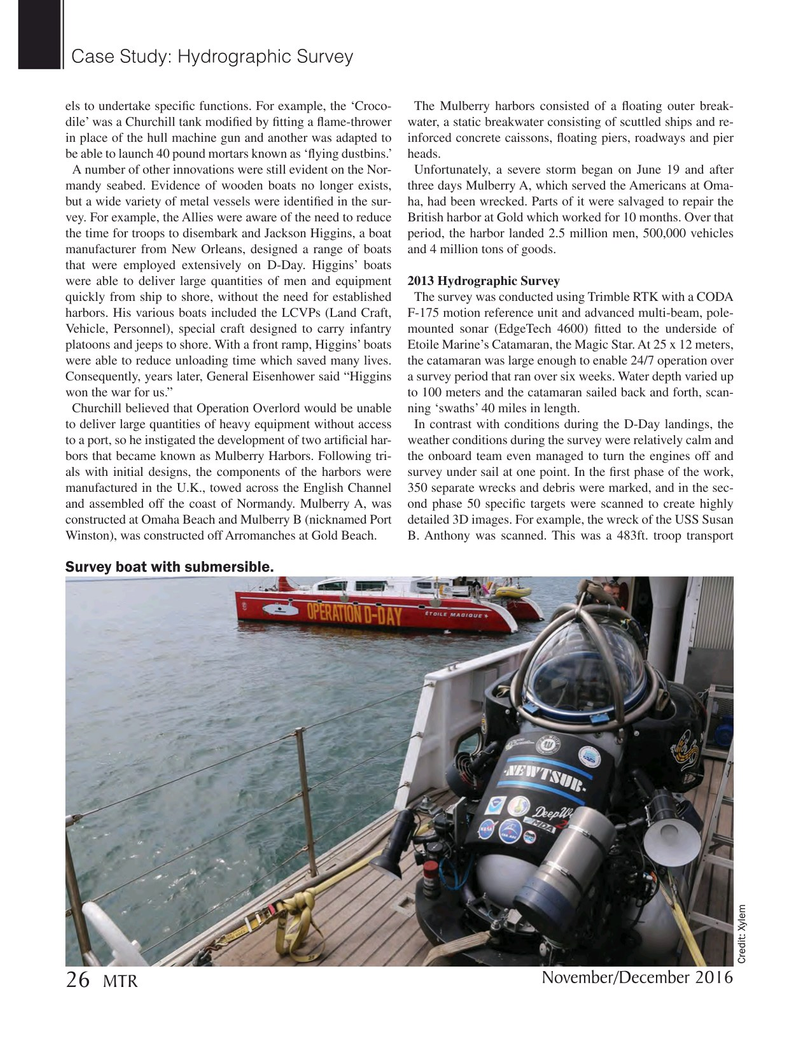
Page 26: of Marine Technology Magazine (November 2016)
Subsea Engineering & Construction
Read this page in Pdf, Flash or Html5 edition of November 2016 Marine Technology Magazine
Case Study: Hydrographic Survey els to undertake speci? c functions. For example, the ‘Croco- The Mulberry harbors consisted of a ? oating outer break- dile’ was a Churchill tank modi? ed by ? tting a ? ame-thrower water, a static breakwater consisting of scuttled ships and re- in place of the hull machine gun and another was adapted to inforced concrete caissons, ? oating piers, roadways and pier be able to launch 40 pound mortars known as ‘? ying dustbins.’ heads.
A number of other innovations were still evident on the Nor- Unfortunately, a severe storm began on June 19 and after mandy seabed. Evidence of wooden boats no longer exists, three days Mulberry A, which served the Americans at Oma- but a wide variety of metal vessels were identi? ed in the sur- ha, had been wrecked. Parts of it were salvaged to repair the vey. For example, the Allies were aware of the need to reduce British harbor at Gold which worked for 10 months. Over that the time for troops to disembark and Jackson Higgins, a boat period, the harbor landed 2.5 million men, 500,000 vehicles manufacturer from New Orleans, designed a range of boats and 4 million tons of goods.
that were employed extensively on D-Day. Higgins’ boats were able to deliver large quantities of men and equipment 2013 Hydrographic Survey quickly from ship to shore, without the need for established The survey was conducted using Trimble RTK with a CODA harbors. His various boats included the LCVPs (Land Craft, F-175 motion reference unit and advanced multi-beam, pole-
Vehicle, Personnel), special craft designed to carry infantry mounted sonar (EdgeTech 4600) ? tted to the underside of platoons and jeeps to shore. With a front ramp, Higgins’ boats Etoile Marine’s Catamaran, the Magic Star. At 25 x 12 meters, were able to reduce unloading time which saved many lives. the catamaran was large enough to enable 24/7 operation over
Consequently, years later, General Eisenhower said “Higgins a survey period that ran over six weeks. Water depth varied up won the war for us.” to 100 meters and the catamaran sailed back and forth, scan-
Churchill believed that Operation Overlord would be unable ning ‘swaths’ 40 miles in length.
to deliver large quantities of heavy equipment without access In contrast with conditions during the D-Day landings, the to a port, so he instigated the development of two arti? cial har- weather conditions during the survey were relatively calm and bors that became known as Mulberry Harbors. Following tri- the onboard team even managed to turn the engines off and als with initial designs, the components of the harbors were survey under sail at one point. In the ? rst phase of the work, manufactured in the U.K., towed across the English Channel 350 separate wrecks and debris were marked, and in the sec- and assembled off the coast of Normandy. Mulberry A, was ond phase 50 speci? c targets were scanned to create highly constructed at Omaha Beach and Mulberry B (nicknamed Port detailed 3D images. For example, the wreck of the USS Susan
Winston), was constructed off Arromanches at Gold Beach. B. Anthony was scanned. This was a 483ft. troop transport
Survey boat with submersible.
Credit: XylemCredit: Xylem
November/December 2016
MTR 26
MTR #9 (18-33).indd 26 MTR #9 (18-33).indd 26 12/7/2016 2:54:59 PM12/7/2016 2:54:59 PM

 25
25

 27
27
